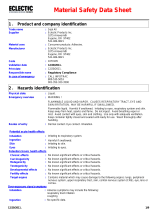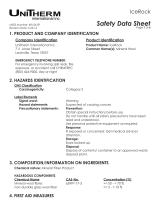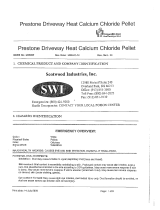Page is loading ...

SAFETY DATA SHEET
Resinoid Bonded Abrasives
For Cutting and Grinding Metals
SDS #1
Page 1 of 6
1. IDENTIFICATION
Product Identity / Trade Name: Grinding and Cutting Wheels, Resinoid (Type 1, Type 27, Type 28, Type 29),
Cup Wheels (Type 11) Cones and Plugs (Type 16, Type 17 and Type 18)
Mounted Point.
Product Use: Abrasive materials used for cutting and grinding metals.
Restriction on Use: Use only as directed
Manufacturer: United Abrasives, Inc.
185 Boston Post Road
North Windham, CT 06256
Internet: www.unitedabrasives.com
Information Phone: (860) 456-7131 Emergency Phone: (860) 456-7131
Date of Preparation: February 15, 2017
2. HAZARD(S) IDENTIFICATION
Classification: This product is not classified as hazardous in accordance with the OSHA Hazard
Communication Standard (29CFR 1910.1200).
Hazards not otherwise classified: Most of the dust/fumes generated in the cutting and grinding process is
from the base material. The exposure to the dust/fumes from the material the potential hazard from this
exposure must be evaluated.
Label Elements:
None required.
3. COMPOSITION / INFORMATION ON INGREDIENTS
Chemical name
CAS No.
Concentration
Aluminum Oxide
1344-28-1
0-95
Zirconium Oxide
1314-23-4
0-80
Cured Phenolic Resin
N/A
1-30
Nitrile Compounds
N/A
1-20
Fluoride Compounds
N/A
1-20
Iron Pyrite
12068-85-8
0-20
Woven Fiberglass
N/A
0-15
Calcium Compounds
N/A
0-15
Sulfur
7704-34-9
0-15
Calcium Oxide
1305-78-8
1-10

United Abrasives SDS #1
Resinoid Bonded Abrasives
For Cutting and Grinding Metals
Page 2 of 6
Cryolite
15096-52-3
1-10
Cured Epoxy Resin
N/A
1-10
Calcium Carbonate
1317-65-3
0-5
Iron Oxide
1309-37-1
0-5
Graphite
7782-42-5
0-5
Aluminum Potassium Fluoride
14484-69-6
0-0.5
Potassium Fluoroborate
14075-53-7
0.1-0.5
Titanium Dioxide
13463-67-7
0.1-0.5
The specific identity and/or exact percentage has been withheld as a trade secret.
4. FIRST-AID MEASURES
Ingestion: If grinding dust is swallowed, seek medical attention.
Inhalation: If overexposed to grinding dust, remove victim to fresh air and get medical attention.
Eye Contact: Flush eyes thoroughly with water, holding open eyelids. Get medical attention if irritation persists.
Obtain immediate medical attention for foreign body in the eye.
Skin Contact: Wash dust from skin with soap and water. Launder contaminated clothing before reuse.
Most important symptoms/effects, acute and delayed: May cause mechanical eye and skin irritation.
Inhalation of dust may cause nose, throat and upper respiratory tract irritation. Prolonged inhalation of high
concentration of dust may cause adverse effects on the lungs. Prolonged overexposure may cause damage to
the respiratory tract, bones and teeth by inhalation.
Indication of immediate medical attention and special treatment, if necessary: Immediate medical
attention is not required.
5. FIRE-FIGHTING MEASURES
Suitable (and unsuitable) extinguishing media: Use any media that is appropriate for the surrounding fire.
Specific hazards arising from the chemical: This product is not combustible, however, consideration must be
given to the potential fire or explosion hazards from the base material being processed. Many materials create
flammable or explosive dusts or turnings when machined or ground.
Special protective equipment and precautions for fire-fighters: Firefighters should wear full emergency
equipment and NIOSH approved positive pressure self-contained breathing apparatus.
6. ACCIDENTAL RELEASE MEASURES
Personal precautions, protective equipment, and emergency procedures: Wear appropriate respirator and
protective clothing as needed to avoid eye contact and inhalation of dust.
Environmental precautions: Avoid release into the environmental. Report releases as required by local, state
and federal authorities.
Methods and materials for containment and cleaning up: Pick up, sweep up or vacuum and place in a
container for disposal. Minimize generation of dust.
7. HANDLING AND STORAGE
Precautions for safe handling: Use only with adequate ventilation. Avoid breathing dust. Wash thoroughly
after handling and use, especially before eating, drinking or smoking. Refer to ANSI B7.1, Safety Requirements
for the Use, Care and Protection of Abrasive Wheels for additional information. Consider potential exposure to

United Abrasives SDS #1
Resinoid Bonded Abrasives
For Cutting and Grinding Metals
Page 3 of 6
components of the base materials or coatings being ground. Refer to OSHA’s substance specific standards for
additional work practice requirements where applicable.
Conditions for safe storage, including any incompatibilities: Store in accordance with ANSI B7.1. Protect
abrasive wheels from damage.
8. EXPOSURE CONTROLS / PERSONAL PROTECTION
Exposure guidelines:
Aluminum Oxide
5 mg/m3 ACGIH TLV (respirable fraction) (as Al metal)
15 mg/m3 TWA OSHA PEL (total dust)
5 mg/m3 TWA OSHA PEL (respirable fraction)
Zirconium Oxide (as zirconium compounds)
5 mg/m3 TWA ACGIH TLV
10 mg/m3 STEL ACGIH TLV
5 mg/m3 TWA OSHA PEL
Cured Phenolic Resin
None Established
Nitrile Compounds
None Established
Fluoride Compounds
2.5 mg/m3 TWA ACGIH TLV
2.5 mg/m3 TWA OSHA PEL
Iron Pyrite
None Established
Woven Fiberglass
5 mg/m3 TWA ACGIH TLV (inhalable)
1 f/cc TWA ACGIH TLV (respirable)
Calcium Compounds
None Established
Sulfur
None Established
Calcium Oxide
2 mg/m3 TWA ACGIH TLV
5 mg/m3 TWA OSHA PEL
Cryolite (as fluorides)
2.5 mg/m3 TWA ACGIH TLV
2.5 mg/m3 TWA OSHA PEL
Cured epoxy resin
None Established
Titanium Dioxide
10 mg/m3 TWA ACGIH TLV
15 mg/m3 TWA OSHA PEL (total dust)
Calcium Carbonate
15 mg/m3 TWA OSHA PEL (total dust)
5 mg/m3 TWA OSHA PEL (respirable fraction)
Iron Oxide
5 mg/m3 TWA ACGIH TLV (respirable fraction)
10 mg/m3 TWA OSHA PEL (fume)
Graphite
2 mg/m3 TWA ACGIH TLV (respirable fraction)
15 mppcf mg/m3 TWA OSHA PEL
Aluminum Potassium Fluoride (as Al metal)
5 mg/m3 ACGIH TLV (respirable fraction) (as Al metal)
15 mg/m3 TWA OSHA PEL (total dust)
5 mg/m3 TWA OSHA PEL (respirable fraction)
Aluminum Potassium Fluoride (as fluorides)
2.5 mg/m3 TWA ACGIH TLV
2.5 mg/m3 TWA OSHA PEL
Potassium Fluoroborate (as fluorides)
2.5 mg/m3 TWA ACGIH TLV
2.5 mg/m3 TWA OSHA PEL
Titanium Dioxide
10 mg/m3 TWA ACGIH TLV
15 mg/m3 TWA OSHA PEL (total dust)
Note: Consider also components of base materials and coatings being ground.
Appropriate engineering controls: Use local exhaust or general ventilation as required to minimize exposure
to dust and maintain the concentration of contaminants below occupational exposure limits.
Individual protection measures, such as personal protective equipment:

United Abrasives SDS #1
Resinoid Bonded Abrasives
For Cutting and Grinding Metals
Page 4 of 6
Respiratory protection: Use NIOSH approved respirator if exposure limits are exceeded or where dust
exposures are excessive. Consider the potential for exposure to components of the coatings or base material
being ground in selecting proper respiratory protection. Refer to OSHA’s specific standards for lead, cadmium,
etc. where appropriate. Selection of respiratory protection depends on the contaminant type, form and
concentration. Select and use respirators in accordance with OSHA 1910.134 and good industrial hygiene
practice.
Skin protection: Cloth or leather gloves recommended.
Eye protection: Safety goggles or face shield over safety glasses with side shields.
Other: Protective clothing as needed to prevent contamination of personal clothing. Hearing protection may be
required.
9. PHYSICAL AND CHEMICAL PROPERTIES
Appearance (physical state, color, etc.): Black, brown or reddish colored solid wheel.
Odor: No Odor
Odor threshold: Not applicable
pH: Not applicable
Melting point/freezing point: Not applicable
Boiling Point: Not applicable
Flash point: Not applicable
Evaporation rate: Not applicable
Flammability (solid, gas): Not combustible
Flammable limits: LEL: Not applicable
UEL: Not applicable
Vapor pressure: Not applicable
Vapor density:
Relative density: Not applicable
Solubility(ies): Not soluble
Partition coefficient: n-octanol/water: Not applicable
Auto-ignition temperature: Not applicable
Decomposition temperature: Not applicable
Viscosity: Not applicable
10. STABILITY AND REACTIVITY
Reactivity: Not reactive.
Chemical stability: Stable.
Possibility of hazardous reactions: None known.
Conditions to avoid: None known.
Incompatible materials: None known.
Hazardous decomposition products: Dust from grinding could contain ingredients listed in Section 3 and
other, potentially more hazardous components of the base material being ground or coatings applied to the base
material.
11. TOXICOLOGICAL INFORMATION
Routes of exposure:
Inhalation: Dust may cause respiratory irritation.
Ingestion: None expected under normal use conditions. Swallowing large pieces may cause obstruction of the
gastrointestinal tract.
Skin contact: None expected under normal use conditions. Rubbing product across the skin may cause
mechanical irritation or abrasions.
Eye contact: Dust may cause mechanical irritation.
Chronic effects from short- and long-term exposure: Long-term overexposure to respirable dust may cause
lung damage (fibrosis) with symptoms of coughing, shortness of breath and diminished breathing capacity.
Chronic effects may be aggravated by smoking. Prolonged overexposure to fluorides may cause a bone
condition, fluorosis. Prolonged exposure to elevated noise levels during operations may affect hearing. A
greater hazard, in most cases, is the exposure to the dust/fumes from the material or paint/coatings being
ground. Most of the dust generated during grinding is from the base material being ground and the potential
hazard from this exposure must be evaluated.

United Abrasives SDS #1
Resinoid Bonded Abrasives
For Cutting and Grinding Metals
Page 5 of 6
Carcinogenicity: Titanium Dioxide is listed by IARC as a group 2B Carcinogen (suspected human carcinogen).
Nove of the other components is listed as a carcinogen or potential carcinogen by OSHA, NTP or IARC.
Additional Information: This SDS is applicable to product from United Abrasives only. The material being
processed must be evaluated to determine any potential hazard.
This product contains titanium dioxide which has caused cancer in rats after high level exposure and inhalation.
No exposure to titanium dioxide has been detected through air sampling during tests to simulate use. Thus,
there are no health effects associated with titanium dioxide during the normal use of this product.
Numerical measures of toxicity:
Aluminum Oxide: LD50 Oral rat >5,000 mg/kg
Zirconium Oxide: Oral rat LD50 >5000 mg/kg
Iron Pyrite: No toxicity data available
Sulfur: Oral rat LD50 >2000 mg/kg, Inhalation rat LC50 >5.43 mg/L/4 hr, Dermal rat LD50 >200 mg/L
Calcium Oxide: Oral rat LD50 >7340 mg/kg
Cryolite: LD50 Oral rat >5,000 mg/kg
Titanium Dioxide: LD50 Oral rat >5,000 mg/kg, Inhalation rat LC50 >6.82 mg/L/4 hr
Calcium Carbonate: No toxicity data available
Iron Oxide: LD50 oral rat > 10000 mg/kg
Graphite: LD50 oral rat > 2000 mg/kg, LC50 inhalation rat > 2 mg/L
Aluminum Potassium fluoride: LD50 oral rat 2150 mg/kg, LC50 inhalation rat > 3.4 mg/L, LD50 dermal rabbit >
2000 mg/kg.
Potassium Fluoroborate: LD50 oral rat > 2000 mg/kg, LC50 inhalation rat > 5.3 mg/L
Titanium Dioxide: LD50 Oral rat >5,000 mg/kg, Inhalation rat LC50 >6.82 mg/L/4 hr
12. ECOLOGICAL INFORMATION
Ecotoxicity:
Aluminum Oxide: 96 hr LC50 Pimephales promelas 35 mg/L
Zirconium Oxide: 96 hr LC50 Danio rerio >100 mg/L, 48 hr EC50 daphnia magna >100 mg/L
Iron Pyrite: No data available
Sulfur: 96 hr LC50 Oncorhynchus mykiss > 5 µg/L (solubility limit of sulfur), 48 hr EC50 daphnia magna > 5 µg/L
(solubility limit of sulfur)
Calcium oxide: 96 hr LC50 Cyprinus carpio >1070 mg/L
Cryolite: No data available
Calcium Carbonate: No data available
Iron Oxide: No data available
Graphite: Danio rerio LC50 > 100 mg/L/96hr
Aluminum Potassium fluoride: Brachydanio rerio LC50 > 10 mg/L/96h
Potassium Fluoroborate: Leuciscus idus LC50: 760 mg/L/96hr
Titanium Dioxide: 48 hr EC50 daphnia magna >500 mg/L
Persistence and degradability: Biodegradation is not applicable to inorganic compounds.
Bioaccumulative potential: No data available
Mobility in soil: No data available.
Other adverse effects: No hazards to the environment are expected from this product. However,
consideration must be given to potential environment effects of the base material being processed.
13. DISPOSAL CONSIDERATIONS
Dispose in accordance with all applicable local, state/provincial and federal regulations. Local regulations may
be more stringent than regional and national requirements. It is the responsibility of the waste generator to

United Abrasives SDS #1
Resinoid Bonded Abrasives
For Cutting and Grinding Metals
Page 6 of 6
determine the toxicity and physical characteristics of the material to determine the proper waste identification
and disposal in compliance with applicable regulations.
14. TRANSPORT INFORMATION
UN Number
Proper shipping name
Hazard
Class
Packing
Group
Environmental
Hazard
DOT
None
Not Regulated
None
None
TDG
None
Not Regulated
None
None
Transport in bulk (according to Annex II of MARPOL 73/78 and the IBC Code): Not applicable – product is
transported only in packaged form.
Special precautions: None identified.
15. REGULATORY INFORMATION
SARA Section 311/312 Hazard Categories: Not Applicable (manufactured articles)
SARA Section 313: This product contains the following toxic chemicals subject to the reporting requirements of
Section 313 of Title III of the Superfund Amendments and Reauthorization Act of 1986 and 40 CFR Part 372
(Toxic Chemical Release Reporting): None
California Proposition 65: WARNING! You create dust when you cut, sand, drill or grind materials such as
wood, paint, cement, masonry or metal. This dust often contains chemicals known to cause cancer, birth defects
or other reproductive harm.
16. OTHER INFORMATION
NFPA Rating: Health = 1 Flammability = 0 Instability = 0
HMIS Rating: Health = 1* Flammability = 0 Physical Hazard =0
*Chronic health hazard
Date Previous Revision: 3/31/15
Date This Revision: 2/15/17
Revision Summary:
8/24/12: Section 3 Updated Composition, Section 8 Updated exposure limits, Section 11 Updated Acute toxicity
values.
3/31/15: Changed all sections. Updated format to GHS.
9/30/16: Section 2 Classification, Hazard Phrases, Precautionary Phrases; Section 3 Composition; Section 8
Exposure guidelines; Section 11 Numerical measures of toxicity; Section 12 Ecotoxicity
The preceding information is believed to be correct and current as of the date of preparation of this Material
Safety Data Sheet. Since the use of this information and the conditions of use of this product are not within the
control of United Abrasives, Inc., it is the user’s obligation to assure safe use of this product.
/




